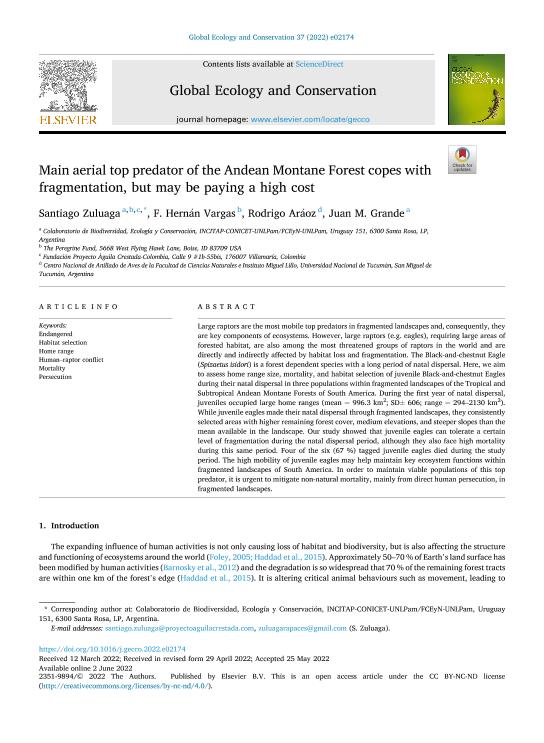Mostrar el registro sencillo del ítem
dc.contributor.author
Zuluaga Castañeda, Santiago

dc.contributor.author
Vargas, F. Hernán
dc.contributor.author
Aráoz, Rodrigo

dc.contributor.author
Grande, Juan Manuel

dc.date.available
2023-09-12T15:22:44Z
dc.date.issued
2022-09
dc.identifier.citation
Zuluaga Castañeda, Santiago; Vargas, F. Hernán; Aráoz, Rodrigo; Grande, Juan Manuel; Main aerial top predator of the Andean Montane Forest copes with fragmentation, but may be paying a high cost; Elsevier; Global Ecology and Conservation; 37; 9-2022; 1-12
dc.identifier.issn
2351-9894
dc.identifier.uri
http://hdl.handle.net/11336/211271
dc.description.abstract
Large raptors are the most mobile top predators in fragmented landscapes and, consequently, they are key components of ecosystems. However, large raptors (e.g. eagles), requiring large areas of forested habitat, are also among the most threatened groups of raptors in the world and are directly and indirectly affected by habitat loss and fragmentation. The Black-and-chestnut Eagle (Spizaetus isidori) is a forest dependent species with a long period of natal dispersal. Here, we aim to assess home range size, mortality, and habitat selection of juvenile Black-and-chestnut Eagles during their natal dispersal in three populations within fragmented landscapes of the Tropical and Subtropical Andean Montane Forests of South America. During the first year of natal dispersal, juveniles occupied large home ranges (mean = 996.3 km2; SD± 606; range = 294–2130 km2). While juvenile eagles made their natal dispersal through fragmented landscapes, they consistently selected areas with higher remaining forest cover, medium elevations, and steeper slopes than the mean available in the landscape. Our study showed that juvenile eagles can tolerate a certain level of fragmentation during the natal dispersal period, although they also face high mortality during this same period. Four of the six (67 %) tagged juvenile eagles died during the study period. The high mobility of juvenile eagles may help maintain key ecosystem functions within fragmented landscapes of South America. In order to maintain viable populations of this top predator, it is urgent to mitigate non-natural mortality, mainly from direct human persecution, in fragmented landscapes.
dc.format
application/pdf
dc.language.iso
eng
dc.publisher
Elsevier

dc.rights
info:eu-repo/semantics/openAccess
dc.rights.uri
https://creativecommons.org/licenses/by-nc-nd/2.5/ar/
dc.subject
ENDANGERED
dc.subject
HABITAT SELECTION
dc.subject
HOME RANGE
dc.subject
HUMAN–RAPTOR CONFLICT
dc.subject
MORTALITY
dc.subject
PERSECUTION
dc.subject.classification
Conservación de la Biodiversidad

dc.subject.classification
Ciencias Biológicas

dc.subject.classification
CIENCIAS NATURALES Y EXACTAS

dc.subject.classification
Ecología

dc.subject.classification
Ciencias Biológicas

dc.subject.classification
CIENCIAS NATURALES Y EXACTAS

dc.subject.classification
Zoología, Ornitología, Entomología, Etología

dc.subject.classification
Ciencias Biológicas

dc.subject.classification
CIENCIAS NATURALES Y EXACTAS

dc.title
Main aerial top predator of the Andean Montane Forest copes with fragmentation, but may be paying a high cost
dc.type
info:eu-repo/semantics/article
dc.type
info:ar-repo/semantics/artículo
dc.type
info:eu-repo/semantics/publishedVersion
dc.date.updated
2023-07-05T15:19:55Z
dc.journal.volume
37
dc.journal.pagination
1-12
dc.journal.pais
Países Bajos

dc.journal.ciudad
Amsterdam
dc.description.fil
Fil: Zuluaga Castañeda, Santiago. Consejo Nacional de Investigaciones Científicas y Técnicas. Instituto de Ciencias de la Tierra y Ambientales de La Pampa. Universidad Nacional de La Pampa. Facultad de Ciencias Exactas y Naturales. Instituto de Ciencias de la Tierra y Ambientales de La Pampa; Argentina. The Peregrine Fund; Estados Unidos. Fundación Proyecto Águila Crestada-Colombia; Colombia
dc.description.fil
Fil: Vargas, F. Hernán. Peregrine Fund; Estados Unidos
dc.description.fil
Fil: Aráoz, Rodrigo. Consejo Nacional de Investigaciones Científicas y Técnicas. Centro Científico Tecnológico Conicet - Tucumán; Argentina. Universidad Nacional de Tucumán. Facultad de Ciencias Naturales e Instituto Miguel Lillo; Argentina
dc.description.fil
Fil: Grande, Juan Manuel. Consejo Nacional de Investigaciones Científicas y Técnicas. Instituto de Ciencias de la Tierra y Ambientales de La Pampa. Universidad Nacional de La Pampa. Facultad de Ciencias Exactas y Naturales. Instituto de Ciencias de la Tierra y Ambientales de La Pampa; Argentina
dc.journal.title
Global Ecology and Conservation
dc.relation.alternativeid
info:eu-repo/semantics/altIdentifier/url/https://www.sciencedirect.com/science/article/pii/S2351989422001767
dc.relation.alternativeid
info:eu-repo/semantics/altIdentifier/doi/https://doi.org/10.1016/j.gecco.2022.e02174
Archivos asociados
